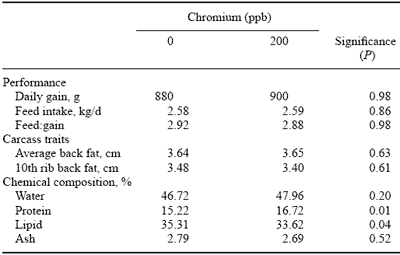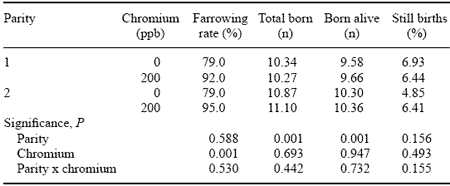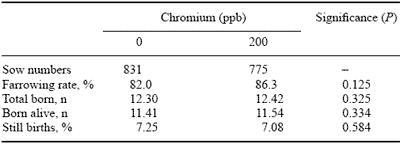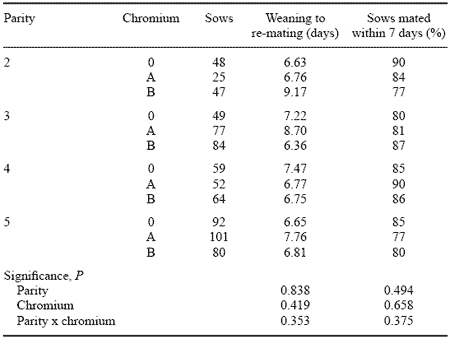Chromium in Pig Production
Chromium and its Role in Pig Production
Interest in chromium as an essential nutrient for pigs and as a possible means of manipulating growth performance and carcass composition was raised initially by reports in the 1960s of growth promotion in rats (Schroeder et al., 1963) and in turkey poults in the late 1970s (Steele and Rosebrough, 1979).
Evidence with humans (Freund et al., 1979) and pigs (Steele et al., 1977) suggested chromium might exert its effects on growth and development by influencing insulin sensitivity and glucose tolerance.
More recently, considerable research has been conducted to explore how supplemental chromium might be used to stimulate the growth performance and possibly even manipulate the carcass composition of pigs. During the same period evidence has arisen suggesting chromium may also play a major role in determining the reproductive performance of sows.
In the present paper I have reviewed the effects of chromium on growth performance and reproduction and have attempted to define the role chromium might play in pig production in the future.
Effects on growth and carcass composition
The reported effects of supplemental chromium on pig growth performance and carcass composition/characteristics might be best described as equivocal.
For example, Page et al. (1992, 1993), Lindemann et al. (1995c) and Mooney and Cromwell (1995) all reported improvements in the carcass composition of pigs offered diets supplemented with chromium from chromium picolinate (for the entire growing-finishing period). In contrast, Ward et al. (1995) found no improvements in the carcass measurements of growingfinishing pigs fed diets supplemented with chromium from chromium acetate, chromium oxalate, chromium nicotinate or chromium picolinate.
It certainly appears that the duration of supplementation is a major factor determining the pig’s response to chromium and that there is little effect of chromium supplementation for relatively short periods during early development (Evok-Clover et al., 1993; Mooney and Cromwell, 1997) although supplementation during the finisher period only has been reported to improve carcass characteristics (Boleman et al., 1995).
Although the causes for variation in the growing-finishing pig’s responses to supplemental chromium remain to be elucidated, the potential of the mineral is best illustrated by the results of Mooney and Cromwell (1997) and those of a recent experiment completed at Bunge Meat Industries (BMI) using castrated males offered corn/soybean meal diets.
The results of Mooney and Cromwell (1997) are summarised in Table 1.
They have to be described as exciting. For example, when comparing the performance and carcass traits of castrated males and females offered diets supplemented with chromium from chromium picolinate and chromium chloride from approximately 19.6 to 108 kg, the authors found quite marked changes in carcass composition and tissue accretion rates due mainly to the organic chromium.
Chromium had no significant effect on growth performance or carcass fat thickness but increased and reduced respectively carcass protein and fat content (Table 1). Chromium supplementation also increased the rate of protein deposition and reduced the rate of fat deposition. Furthermore, chromium supplementation increased the amount of dissected lean in the ham by 5.4%. The corresponding reduction in dissected fat was 8.2%.
The results of the recently completed experiment at BMI showed that supplementing the diets offered castrated male pigs between 30 and 110 kg with 200 ppb chromium (from chromium picolinate) reduced feed intake when protein intake was above requirement, reduced P2 fat thickness measured ultrasonically at 110 kg and reduced the L value of the Longissimus dorsi (i.e., made the muscle less white).
The results of both experiments leave no doubt that chromium can and does affect tissue metabolism and that the effects are probably mediated through changes in the relative sensitivity of muscle and fat tissue to nutrient supply/demand.
Table 1. Effects of organic chromium supplementation on the performance, carcass traits and carcass composition of pigs offered feed ad libitum from 19.0 to approximately 108 kg (from Mooney and Cromwell, 1997).
The results also suggest that the changes in body composition elicited by chromium are not necessarily reflected in the ‘traditional’ linear fat measurements.
Whilst the latter is not surprising, given the rather simplistic selection techniques used by most breeding companies, it is a factor which has to be taken into account when assessing the impact/effects and potential of chromium and other products for pig meat production.
I believe that on the information available chromium has the potential to improve the efficiency of pig meat production and further research is warranted with growing-finishing stock. It is important to better understand the modes of action of chromium, and in doing so more accurately define the circumstances under which chromium will ‘enhance’ growth performance and(or) carcass lean content.
Effects of chromium on reproduction
Sow productivity remains a major factor determining the profitability of pig meat production via its direct effects on volume and ability to meet budgeted numbers and more indirectly through its effect on the overhead component of cost of production.
Although the factors affecting fertility and fecundity are reasonably well understood, there have been few major advances in reproductive capacity/efficiency over the last decade and if anything, a general decline in the reproductive performance of commercial herds.
Recent evidence suggests that chromium supplementation may improve sow productivity by affecting both fertility (Campbell et al., unpublished data) and fecundity (Lindemann et al., 1995a,b,c).
A number of large scale experiments have been conducted at BMI to investigate if chromium supplementation might have a role in improving reproductive capacity of commercial herds and under what circumstances the material is most effective. This section of the paper summarises the work conducted at BMI to date and attempts to establish the short and longer term potential of organic chromium supplementation for sows.
EFFECTS DURING GESTATION IN YOUNG SOWS
The results of an experiment conducted with gilts (parity 1) and parity 2 (second litter) sows fed diets supplemented with 200 ppb chromium from picolinate are presented in Table 2. The diet was fed restrictively at 2.2 kg/day to the experimental animals from the day after mating through to farrowing. In contrast to the results of Lindemann et al. (1995c), chromium supplementation of the diet fed during gestation had no effect on litter size but the latter was higher for second litter sows (Table 2).
However, chromium supplementation improved farrowing rate (P < 0.001) by 11 and 13 percentage units, respectively, in first and second litter sows.
In analysing the reasons for the marked difference in farrowing rate between the two experimental groups (Table 3) it was found that chromium tended to improve the overall health of the animals resulting in fewer deaths and abortions. The number of sows found not pregnant after day 42 was reduced from 6.0 to 1.6% whilst the number of sows which returned to heat before 42 days was similarly reduced by chromium supplementation.
Table 2.Interrelationship between parity and dietary organic chromium during gestation on the subsequent reproductive performance of sows.
Table 3. The fate of sows between mating and farrowing.
The exact mechanism underlying the responses to chromium supplementation observed in this experiment remains to be established. However, there is increasing evidence that insulin and the insulin sensitivity of sow’s tissues can influence both fertility and litter size (Ramierez et al., 1994).
The present results suggest that if the mode of action is insulin-related, then the effects extend beyond the oestrous cycle to fertilisation/implantation. Alternatively, the improvement in farrowing rate elicited by chromium supplementation may be associated with a general improvement in sow health which in turn could be related to insulin sensitivity and blood glucose levels particularly during pregnancy.
The results of the experiment raised questions about the responsiveness of older sows to chromium supplementation and whether litter size could be affected by supplementing the sow diet with chromium in the periods before farrowing, during lactation and for the first 35 days after weaning. Two experiments with older sows were conducted to answer some of these questions.
EFFECTS OF CHROMIUM SUPPLEMENTATION DURING DIFFERENT PHASES OF THE REPRODUCTIVE CYCLE IN OLDER SOWS
The results of two experiments conducted at different production units within BMI are given in Tables 4 through 7. The results in Tables 4 and 5 relate to an experiment conducted with sows at site 1 fed a control diet or the same diet supplemented with 200 ppb chromium (from picolinate) for the first 35 days after mating. The results in Tables 6 and 7 relate to sows fed control diets or the same diets supplemented with 200 ppb chromium for 28 days prior to farrowing only or for 28 days prior to farrowing, throughout lactation and for 35 days after mating at site 2.
Table 4.The effects of supplementing the diet fed sows for 35 days after mating with organic chromium on subsequent fertility and litter size (site 1).
Table 5. The interrelationship between parity and chromium supplementation for 35 days after mating on the weaning to re-mating interval and proportion of sows mated within 7 days of weaning (site 1).
The results for site 1 showed that sows fed the diet supplemented with chromium from mating to 35 days post-mating tended to have a higher farrowing rate but the same litter size as their control counterparts (Table 4).
It was also interesting that the weaning to re-mating interval was reduced in parity 3 sows by chromium and there was a tendency for the proportion of sows returning to oestrus (mated) within 7 days of weaning to be improved by chromium supplementation (P = 0.093). The results showed that the latter indicator of fertility was lowest for parity 3 sows and it was this group which exhibited the largest responses to supplementation (Table 5).
Table 6. The effects of including organic chromium (200 ppb) in the diet fed sows for 28 days before farrowing (A) or for 28 days before farrowing during lactation and 35 days post-mating (B) on subsequent fertility and litter size (site 2).
The results for site 2 showed that supplementation of the sow diet with chromium for 28 days before farrowing through to 35 days post-weaning had little effect on any measure or indicator of fertility or fecundity (Tables 6 and 7).
Table 7.The effects of parity and chromium supplementation (200 ppb) of the diet fed sows for 28 days before farrowing (A) or for 28 days before farrowing throughout lactation and for 35 days after weaning (B) on the weaning to re-mating interval and the number of sows mated within 7 days of weaning (site 2).
Although the results of the two experiments appear to be conflicting, they are open to numerous interpretations regarding the mode of action of chromium and the most sensitive periods of the reproductive cycle to dietary chromium supplementation.
The difference in responses may simply reflect differences in the inherent fertility of the animals/herds involved. For example, results for the weaning to re-mating interval and farrowing rate show that despite the similarity in the size of the two units (5,700–6,000 sows) and the fact that they have the same genetics, diets and buildings; the herd at site 1 appears less fertile or has more problems with fertility than that at site 2.
The difference in fertility may be associated with animal/insulin sensitivity factors which would explain the improvement in fertility in response to chromium supplementation at site 1 but not at site 2. Similarly, in the first experiment reported here the farrowing rate of the control animals was only 79%. Although not uncommon for young sows, this is considerably below the animals’ inherent potential.
Ramierez et al. (1994, 1997) reported marked improvements in the fertility and fecundity of sows in response to exogenous insulin administration after weaning. They also reported that the largest improvements were achieved in herds with ‘low’ inherent fertility. The latter is a common and increasing problem in commercial pig production. The cause remains to be established, but there is increasing evidence that sow health and insulin sensitivity may be related components of the problem. The ‘problem’ seems responsive to chromium supplementation.
Summary
The results of Ramierez et al. (1994, 1997) represent one of the more exciting findings in sow reproduction in the last decade and provide us with an insight into the possible modes of action of chromium supplementation on reproduction and possibly even growth and development.
These results and those of the experiments conducted at BMI suggest that when used for relatively short periods during the reproductive cycle, chromium has the potential to improve the fertility but not necessarily the litter size of sows.
The magnitude of the improvement in fertility and the indicators of the latter, namely weaning to re-mating interval and the proportion of sows returning to oestrus with 7 days, appears to be related to the inherent fertility of the herd or animals involved. The responses are more pronounced in younger sows and when the material is fed throughout gestation.
The results from BMI do not support the litter size effects reported by Lindemann et al. (1995c). However, the apparent difference in results may be associated with the periods over which the sows were fed diets supplemented with chromium or with differences in inherent or basal litter size.
The latter was considerably lower in the earlier work reported by Lindemann than in any of the experiments reported here.
The present results demonstrate the variability in response in sows to dietary chromium supplementation likely to be observed. There is little doubt that this reflects differences in the factors constraining fertility. Until the modes of action of chromium are better understood it will be difficult to provide definitive recommendations on the utilisation of chromium to improve the reproductive performance of sows.
However, the potential of the material is obvious and in the short term chromium would appear to have a strategic use for younger sows (parity 1 and 2), herds with low inherent fertility and during periods of reduced seasonal infertility.
| Conclusions There seems little doubt that a change in glucose tolerance is a component of the ‘ageing’ process in pigs and one of the major reasons the growing pig’s capacity for protein deposition, and consequently efficient and lean growth, declines with age/weight. The bulk of the evidence available on the metabolic role of chromium suggests the mineral can and does alter (improve) glucose tolerance and in doing so can and does improve growth performance and(or) body composition. The same mode of action appears responsible for the improvements in sow reproductive performance in response to chromium supplementation during various phases of the reproductive cycle. For sows, the available evidence suggests that chromium supplementation tends to improve the general health of the animal and results in improved reproductive performance under circumstances where the latter is constrained by glucose and expressed as intolerance. Identification of such situations is more evident in sows (e.g., low fertility/fecundity herds, young sows, summer infertility period) than growing pigs and more work is required on the latter. The work is certainly warranted and it is likely that chromium will play a major role in the efficient and cost effective production of pig meat in the future. |
References
Author: ROGER G. CAMPBELLBoleman, S.L., S.J. Boleman, T.D. Bidner, T.L. Ward, L.L. Southern, J.E. Pontif and M.M. Pike. 1995. Effect of chromium picolinate on growth, body composition, and tissue accretion in pigs. J. Anim. Sci. 73:2033.
Evock-Clover, C.M., M.M. Polansky, R.A. Anderson and N.C Steele. 1993. Dietary chromium supplementation with or without somatotropin treatment alters serum hormones and metabolites in growing pigs without affecting growth performance. J. Nutr. 123:1504.
Freund, H., S. Atamian and J.E. Fischer. 1979. Chromium deficiency during total parenteral nutrition. J. Am. Med. Assoc. 241:496.
Lindemann, M.D., A.F. Harper and E.T. Kornegay. 1995a. Further assessment of the effects of supplementation of chromium from chromium picolinate on fecundity in swine. J. Anim. Sci. 73 (Suppl. 1):303.
Lindemann, M.D., A.F. Harper and E.T. Kornegay. 1995b. Further assessment of the effects of supplementation of chromium from chromium picolinate on fecundity in swine. J. Anim. Sci. 73:(Suppl. 1):185.
Lindemann, M.D., C.M.Wood, A.F. Harper, E.T. Kornegay and R.A. Anderson. 1995c. Dietary chromium picolinate additions improve gain:feed and carcass characteristics in growing-finishing pigs and increase litter size in reproducing sows. J. Anim. Sci. 73:457.
Mooney, K.W. and G.L. Cromwell. 1995. Effects of dietary chromium picolinate supplementation on growth, carcass characteristics and accretion rates of carcass tissues in growing-finishing swine. J. Anim. Sci. 73:3351.
Mooney, K.W. and G.L. Cromwell. 1997. Efficiency of chromium picolinate and chromium chloride as potential carcass modifiers in swine. J. Anim. Sci. 75:2661.
Page, T.G., L.L. Southern, T.L. Ward, J.E. Pontif, T.D. Bidner and D.L. Thompson, Jr. 1992. Effect of chromium picolinate on growth, serum and carcass traits, and organ weights of growing-finishing pigs from different ancestral sources. J. Anim. Sci. 70(Suppl. 1):235.
Page, T.G., L.L. Southern, T.L. Ward and D.L. Thompson, Jr. 1993. Effect of chromium picolinate on growth and serum and carcass traits of growingfinishing pigs. J. Anim. Sci. 71:656.
Ramierez, J.L., N.M. Cox and A.B. Moore. 1994. Enhancement of litter size in sows by insulin administration prior to breeding. J. Anim. Sci. 72 (Suppl. 1):79.
Ramierez, J.L., N.M. Cox and A.B. Moore. 1997. Influence of exogenous insulin before breeding on conception rate and litter size of sows. J. Anim. Sci. 75:1893.
Schroeder, H.A,W.H. Vinton, Jr. and J.J. Balassa. 1963. Effects of chromium, cadmium and lead on the growth and survival of rats. J. Nutr. 80:48.
Steele, N.C. and R.W. Rosebrough. 1979. Trivalent chromium and nicotinic acid supplementation for the turkey poult. Poult. Sci. 58:983.
Steele, N.C., T.G. Althen and L.T. Frobish. 1977. Biological activity of glucose tolerance factor in swine. J. Anim. Sci. 45:1341.
Ward, T.L., L.L. Southern and R.A. Anderson. 1995. Effect of dietary chromium source on growth, carcass characteristics, and plasma metabolite and hormone concentrations in growing-finishing pigs. J. Anim. Sci. 73:(Suppl. 1):189.
Bunge Meat Industries, Corowa, New South Wales, Australia






.jpg&w=3840&q=75)